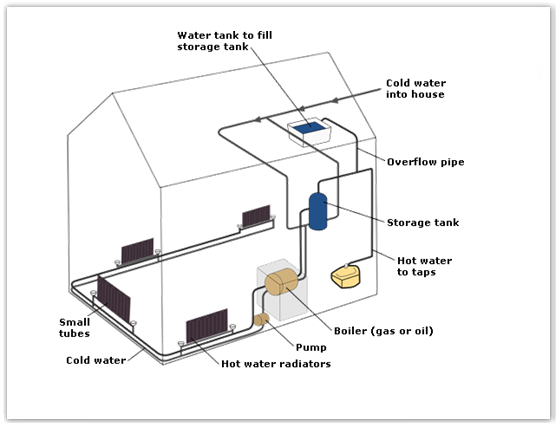Graph Writing # 80 - How a central heating system in a house works
- Details
- Written by IELTS Mentor
IELTS Academic Writing Task 1/ Graph Writing - Process Diagram:
» You should spend about 20 minutes on this task.
The diagram below shows how a central heating system in a house works.
Summarise the information by selecting and reporting the main features, and make comparisons where relevant.
» Write at least 150 words.

Sample Answer 1:
The given diagram shows how a central heating system of a house works. As is observed from the illustration, the central heating machine comprises several mechanical aspects and forms a complex system.
According to the given illustration, for the central heating machine to work the cold water supply is required and this water flows to the storage tank and the overflow pipe is there to store the excess water in storage. The water is passed through a boiler which is either gas or oil driven and a pump is connected with it. The radiators are connected with the boiler and these radiators are made of small tubes. When the cold water passes through the pump and boiler, it gains temperatures and become hot water and from the water taps, the house members get hot water. Thus the whole system that covers the house keeps it warm.
In summary, the central heating system mainly works by flowing water through the house and increasing the temperature of it.
Model Answer 2:
The given picture illustrates how a central heating system operates in a typical house in order to keep internal climate and tap water at a pre-set temperature. The process runs through two stages, starting at a transitory state until reaching a steady state.
In the transitory stage, the main goal is to fill the heater´s piping circuit up with water. Initially, cold water is taken from the local water utility supplier and passed through a boiler, which is a device designed to exchange energy between burned fuel (gas or oil) and water, this fluid is then pumped through some tubes and radiators, which are equipment used for exchanging temperature between the running fluid and the air inside the house. Finally, water reaches back to the boiler. The amount of water taken from the utility service has a specific volume according to an engineering design, this stage continually repeats until the water gets a predefined temperature.
Once the system has reached the pre-set temperature, that is when it gets to steady state, thanks to the high pressure on the piping circuit, water is transported to a storage tank from the boiler, after the storage tank is completed, water runs down to a sink and when the pressure again is high enough, water deviates towards a spare water tank which functions as a water reserve for when the service is interrupted.
[Written by - Sebastián Gómez Vidal]

Overall, it can be seen that the central heating system works through a sophisticated procedure where it requires 3 steps for the hot water to reach the taps and more stages are needed for the radiators to be heated. Moreover, several instruments such as a storage tank, boiler, pump and hot water radiator are required for this complex process.
The process begins when cold water is supplied from the outside source and it is flowed down to the storage tank. After reaching the storage tank, excess cold water is moved via an overflow pipe to the water tank for reservation. In the next stage, water is transferred to the boiler, which runs by gas or oil and it is responsible for heating the water. When this stage is completed, the hot water can either go to the taps for use in the households or to the hot water radiators for warming the house.
Hot water radiators are made up of small tubes which radiates the heat of the hot water in order to keep the house warm. When the temperature of the water is completely dissipated and it becomes cold, then this water can be pumped back to the boiler by a pump attached with it for reuse.
To begin with, cold water is pumped into the house from the roof, where a water tank is also present. The water is sent to the storage tank directly from the tank; overflown water from the water tank is also sent to the storage tank with the help of another pipe. From the storage tank, the water is then sent to the boiler, which uses gas or oil to heat the water. This hot water is distributed to several rooms with the help of a pipe, where already installed water radiators maintain the water temperature with the help of its small tubes system. As soon as this water is cooled down, it is brought back to the boiler with the help of a pump. This process continues to keep the temperature warm inside a house. The excessive hot water is stored in the storage tank from where it can be mixed with the tank water and can be used from taps.
Report